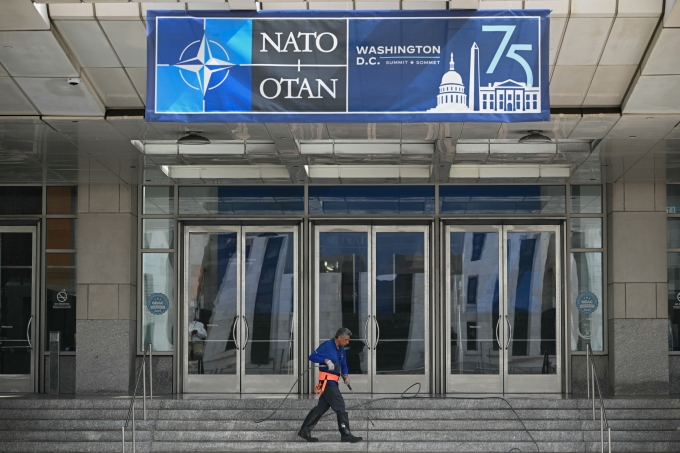
Recent efforts by the Trump administration to improve relations with Russia have left NATO scrambling to prepare for a future without firm U.S. support.
The heated clash between President Donald Trump and Ukrainian President Volodymyr Zelensky at the White House late last month was seen as a major blow to NATO, a military alliance long considered a cornerstone of the post-World War II global order.
Trump has taken a position that many European allies view as favoring Russia and President Vladimir Putin, dismissing Ukraine’s security concerns at a time when Kyiv desperately needs Western support. During his Oval Office meeting with Zelensky, Trump bluntly told him that Ukraine had "no leverage" in negotiations.
Last month, Trump also surprised U.S. allies by holding a phone call with Putin without prior consultation with Ukraine or European partners. Since then, U.S.-Russia relations have improved, with high-level meetings and positive rhetoric between the two governments. The shift has effectively ended the West’s three-year effort to isolate Moscow.
Analysts argue that the U.S.’s changing stance on Russia contradicts NATO’s core mission. The alliance, founded 75 years ago to counter Moscow, has long relied on the assumption that the U.S. would use its military superiority—including its nuclear arsenal—to protect any member under attack. But this foundation is now in question, as Trump has repeatedly threatened to pull the U.S. out of NATO.
"I worry that we may be witnessing NATO’s final days," said retired Admiral James Stavridis, former NATO Supreme Allied Commander. "The alliance isn’t collapsing yet, but it’s weaker than at any time in my military career."
When asked about Trump’s commitment to NATO, the White House on March 3 pointed to his recent remarks alongside British Prime Minister Keir Starmer, in which he said he "supports" NATO’s Article 5, the alliance’s collective defense clause.
During his February 28 meeting with Zelensky, Trump also stated, "We are committed to NATO," and praised Poland, a NATO member, for its defense spending.
However, just a day later, Trump’s close advisor, billionaire Elon Musk, endorsed a social media post calling for the U.S. to withdraw from NATO and the United Nations.
Musk’s comments were echoed by Republican Senator Mike Lee, a frequent NATO critic, who questioned why the U.S. remained in the alliance. "Let’s get out of NATO. Now is the right time to leave," Lee posted.
European Leaders Plan for a Future Without U.S.
"The idea of pulling the U.S. out of NATO and improving relations with Russia has been around since Trump’s first term," said Ruth Deyermond, a senior security lecturer at King’s College London.
Deyermond noted that in Trump’s second term, many of his key allies—including Musk and Secretary of State Marco Rubio—are more open to reconsidering previous U.S. policies on confronting Russia and supporting Ukraine.
European leaders, who have long depended on NATO for security, have largely avoided openly criticizing Trump’s position, but some have begun discussing alternatives.
"We want to maintain the transatlantic partnership and collective strength, but the White House dispute made it clear that Europe cannot be naive. We must take care of our own interests, values, and security," German Foreign Minister Annalena Baerbock said on March 1.
On March 2, European leaders met in London, vowing to develop a peace plan for Ukraine while rejecting claims that the White House dispute had harmed the transatlantic alliance.
"I do not accept the idea that the U.S. is an unreliable ally," said British Prime Minister Starmer.
Europe’s "Ready Coalition"
The UK and France are leading efforts to form a "ready coalition" to ensure Ukraine’s security in any ceasefire deal. Their plan includes deploying peacekeeping troops and military equipment while hoping to persuade Trump to contribute key military assets Europe lacks, such as intelligence, reconnaissance, and air defense systems.
European NATO members have long underinvested in defense, traditionally relying on the U.S. to provide advanced military systems and coordinate alliance forces.
Rose Gottemoeller, former NATO Deputy Secretary-General and chief U.S. arms negotiator with Russia, said NATO allies first began questioning U.S. commitment in 2017, when Trump refused to endorse the alliance’s collective defense pledge unless European members increased military spending to at least 2% of GDP.
Since then, NATO countries have ramped up defense spending. On his recent visit to NATO headquarters, U.S. Defense Secretary Pete Hegseth reaffirmed Washington’s commitment to the alliance but urged European nations to further increase their defense budgets.
A Shift in U.S. Priorities
The key difference now is Trump’s approach to Russia. His administration’s recent statements suggest a shift toward Moscow’s perspective.
On March 2, Trump wrote on his social media platform Truth Social:
"We should spend less time worrying about Putin and more time worrying about migrant gangs, drug lords, murderers, and people from mental institutions invading our country. We don’t want to end up like Europe."
Last weekend, he went even further, accusing the European Union of being founded to "drain money from the U.S."
Meanwhile, most European NATO leaders still consider Russia the primary security threat. A full-scale Russian attack on Europe remains unlikely, but the prospect of a ceasefire in Ukraine is raising alarms. Many traditional U.S. allies fear a deal could give Russia time to rebuild its military, economy, and global influence.
Before Trump took office, a survey of nearly 400 European security experts identified 30 major threats to the continent this year. They ranked a ceasefire deal favoring Russia as the most serious concern. Washington’s "America First" policies and its withdrawal of security guarantees for Europe were also high on the list.
"European fears have been validated by what we’ve seen in the past few weeks," said Veronica Anghel, a researcher at the European University Institute.
European governments are now racing to rebuild their militaries in case U.S. support disappears. The EU has approved a plan to spend over $860 billion on "rearming Europe" and increasing its capacity to handle security challenges independently.
However, the biggest obstacle is that the EU is not a military alliance. Its main function is coordinating member states’ efforts and supporting Europe’s inefficient arms industry.
Unlike NATO, Europe lacks its own centralized military command. While there have been discussions about forming a multinational European combat force, little progress has been made.
Now, leaders are being forced to consider what collective defense would look like without the U.S.
A NATO Without America?
Discussions about Ukraine’s future are increasingly tied to how Europe must create a security framework independent of U.S. decision-making. The next step is determining how to defend European territory without relying on American military assets.
"Figuring out how to fill the gap left by a weakened U.S. commitment is a political challenge that requires immediate discussion and action," said Giuseppe Spatafora, a former NATO planner and now an analyst at the EU Institute for Security Studies.
Some observers argue that Trump’s actions are an attempt to push NATO allies to take more responsibility, though they warn this approach could backfire.
"Trump’s policies have diverged so dramatically from NATO’s traditional stance that they’re causing seismic shifts," said Gordon Davis, a former senior NATO official. "If this continues, he risks creating more distrust and resistance, making it harder for the U.S. to gain support from allies in ending the Ukraine conflict."
A 75-Year Alliance in Jeopardy
After 75 years, European leaders are considering a future without NATO as they know it.
"When NATO members start doubting whether their allies will protect them, that’s the beginning of the end of the alliance," said Peter Bátor, Slovakia’s former ambassador to NATO.
(Sources: WSJ, Moscow Times, NBC News)
Hello Shuttle will strive to bring the latest updates. At the end of the day.
Are you looking for reliable airport and cruise port transfer services in Los Angeles?
We offer professional, safe, and punctual transportation from
Los Angeles Airport - LAX
Long Beach Airport - LGB
John Wayne Airport - SNA
San Pedro cruise port
Long Beach cruise port
Disneyland
and other destinations.
Let us make your journey stress-free and comfortable with our dedicated drivers and high-quality vehicles. Book now for the perfect travel experience at www.helloshuttle.com or call 944-800-5678!


